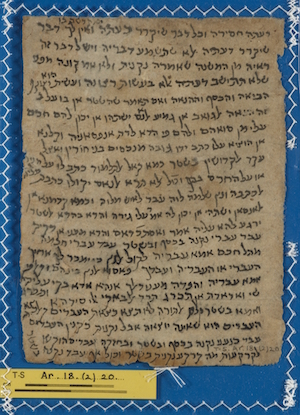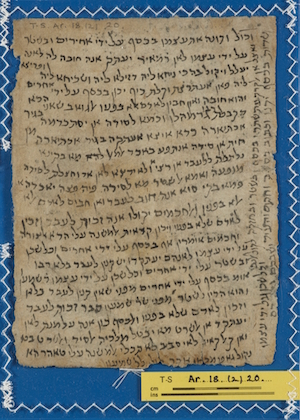What women want (most)? A feminist reading of the Talmud from the Middle Ages: T-S Ar.18(2).20
by Zvi Stampfer
The quandary of ‘what women want’ is not a modern one, but is apparently one that has bothered men since time immemorial. An interesting attempt to address this issue was made by a medieval Jewish scholar in his commentary on tractate Qiddushin of the Babylonian Talmud. The Genizah fragment T-S Ar.18(2).20, written in a mixture of Hebrew and Judaeo-Arabic (as well as a few Aramaic quotations), contains part of this commentary.

Detail of T-S Ar.18(2).20 verso, lines 1-7, Cambridge University Library
In this fragment the anonymous commentator explains to his (most probably male) readers: ‘There is nothing that satisfies her more than that you will listen to her’. The commentator supports his argument with reference to the Jewish sources of Late Antiquity, the Mishna, and the Talmud, but adds a new and interesting creative interpretation. The Mishna (Qiddushin 1:1) states: ‘A woman is acquired in three ways’, and the sages of the Talmud ask two simple questions: (1) why does the Mishna use the word ‘acquired’ as if a woman is ‘bought’ or ‘acquired’, instead of saying ‘a woman becomes betrothed in three possible ways’; (2) Why use the passive voice and not simply say ‘a man betroths a woman in three possible ways’? Unfortunately – as is often the case with Genizah fragments – we don’t have the commentary on the Talmud’s explanation of the first question as to the use of ‘acquired’, but we do have what remains of the commentary on the second question.
The Talmud states that the Mishna chose to put the focus on the woman in order to emphasise that the marriage cannot take place without her will. Our commentator takes this one step further and offers an interpretation that can be seen as a ‘feminist reading’ of the Talmud. According to this interpretation, the Jewish sages taught that in the marriage contract the groom is seemingly active and the bride is passive, while in fact the opposite is the case. The groom’s role in the ceremony is to satisfy the bride’s will and to act accordingly. This is why the groom gives his bride a ring (or equivalent). Perhaps our anonymous commentator sought to advise young couples in how they should interact and respect each other throughout their married life.
It is fascinating to see a medieval scholar espousing such an apparently ‘modern’ approach to the relationship between husband and wife. The concept that women have their own will, separate from that of their husband – a will that men should listen to and respect – is relatively uncommon in medieval literature. Furthermore, our medieval scholar undertook a creative re-reading of the traditional Jewish text. While maintaining a respect for the authority of the texts (as well as the patriarchal structure), he used them as a source of authority for propounding his ideas on the relations between the sexes into the very texts that seem to posit the opposite.
T-S Ar.18(2).20 verso, Cambridge University Library
T-S Ar.18(2).20 recto, Cambridge University Library
My research is generously supported by the Parasol Foundation

Cite this article
(2016). What women want (most)? A feminist reading of the Talmud from the Middle Ages: T-S Ar.18(2).20. [Genizah Research Unit, Fragment of the Month, April 2016]. https://doi.org/10.17863/CAM.7895
If you enjoyed this Fragment of the Month, you can find others here.
Contact us: genizah@lib.cam.ac.uk
The zoomable images are produced using Cloud Zoom, a jQueryimage zoom plugin:
Cloud Zoom, Copyright (c) 2010, R Cecco, www.professorcloud.com
Licensed under the MIT License


